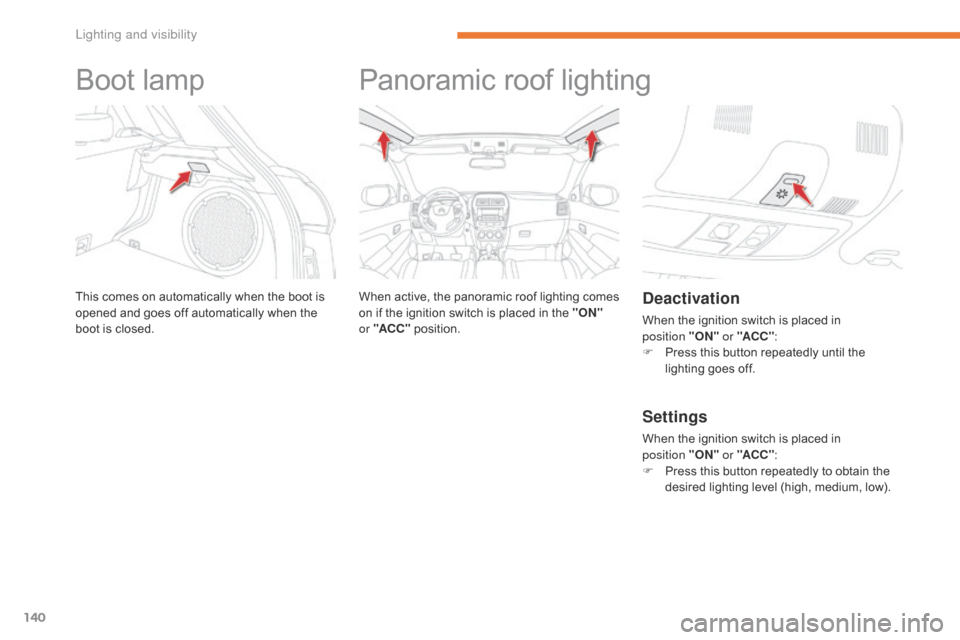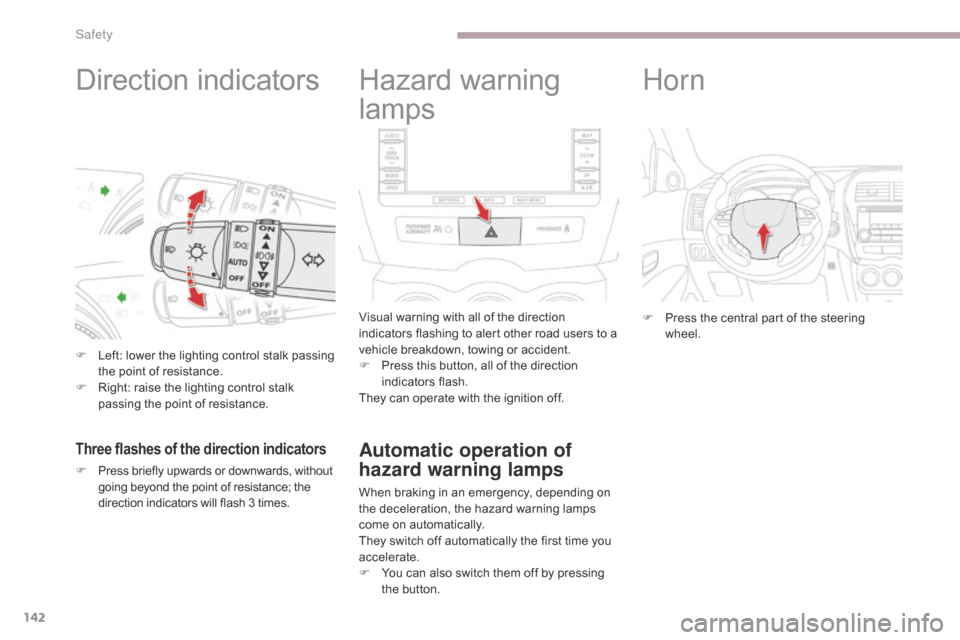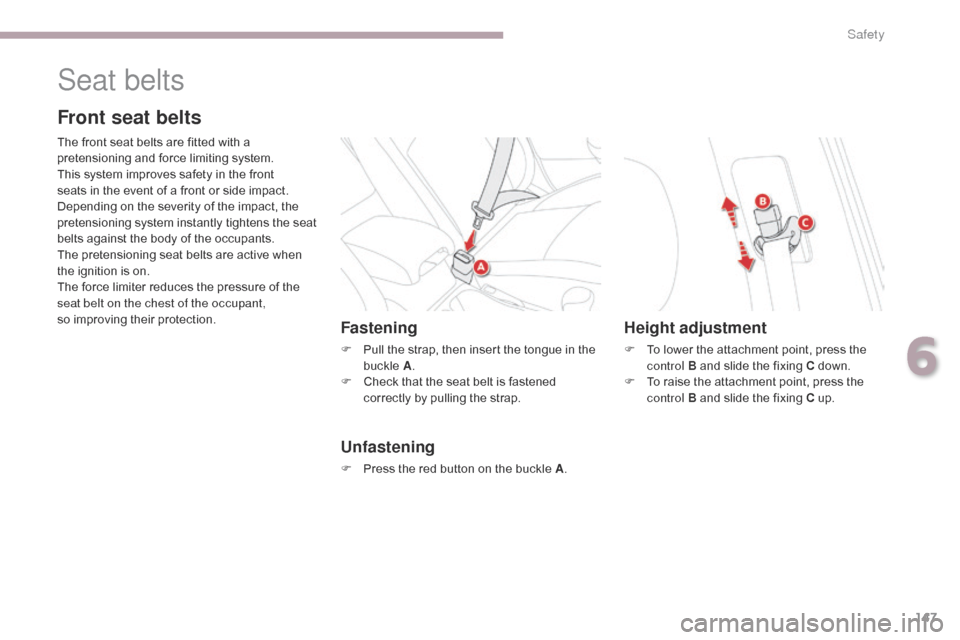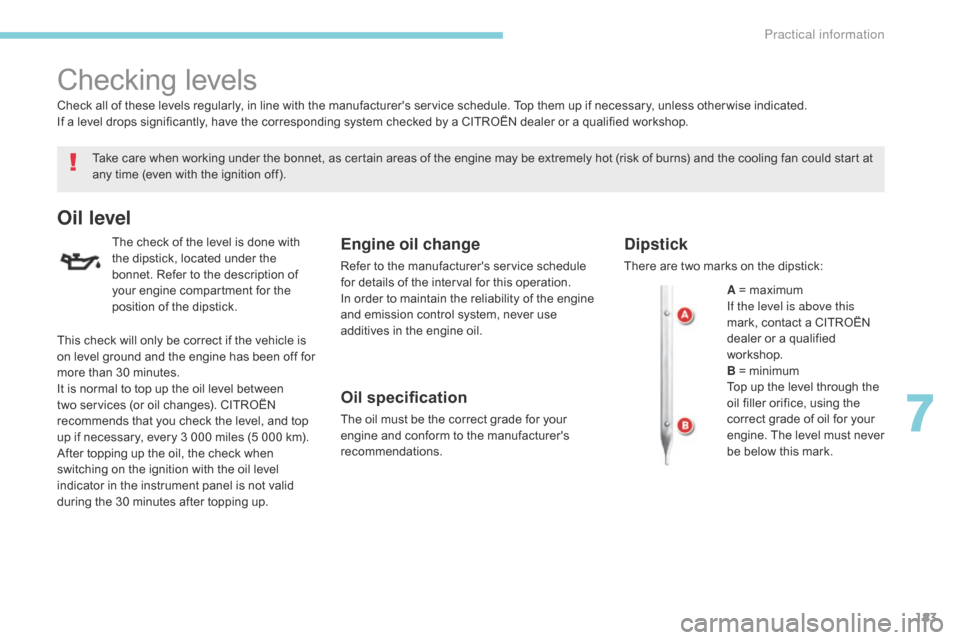ignition Citroen C4 AIRCROSS 2017 1.G Workshop Manual
[x] Cancel search | Manufacturer: CITROEN, Model Year: 2017, Model line: C4 AIRCROSS, Model: Citroen C4 AIRCROSS 2017 1.GPages: 368, PDF Size: 11.54 MB
Page 142 of 368

140
C4-Aircross_en_Chap05_Eclairage-et-visibilite_ed01-2016
Boot lamp
This comes on automatically when the boot is
opened and goes off automatically when the
boot is closed.
Panoramic roof lighting
When active, the panoramic roof lighting comes
on if the ignition switch is placed in the "ON"
or "ACC " position.Deactivation
When the ignition switch is placed in
position
"ON" or "ACC " :
F
P
ress this button repeatedly until the
lighting goes off.
Settings
When the ignition switch is placed in
position "ON" or "ACC ":
F
P
ress this button repeatedly to obtain the
desired lighting level (high, medium, low).
Lighting and visibility
Page 144 of 368

142
C4-Aircross_en_Chap06_securite_ed01-2016
Direction indicators
F Left: lower the lighting control stalk passing the point of resistance.
F
R
ight: raise the lighting control stalk
passing the point of resistance.
Three flashes of the direction indicators
F Press briefly upwards or downwards, without going beyond the point of resistance; the
direction indicators will flash 3 times.
Hazard warning
lamps
Visual warning with all of the direction
indicators flashing to alert other road users to a
vehicle breakdown, towing or accident.
F
P
ress this button, all of the direction
indicators flash.
They can operate with the ignition off.
Automatic operation of
hazard warning lamps
When braking in an emergency, depending on
the deceleration, the hazard warning lamps
come on automatically.
They switch off automatically the first time you
accelerate.
F
Y
ou can also switch them off by pressing
the button.
Horn
F Press the central part of the steering wheel.
Safety
Page 145 of 368

143
C4-Aircross_en_Chap06_securite_ed01-2016
Group of supplementary systems which help
you to obtain optimum braking in complete
safety in emergency situations:
-
a
nti-lock braking system (ABS),
-
e
lectronic brake force distribution (EBFD).
Braking assistance systems
Anti-lock braking system
and electronic brake force
distribution
Linked systems which improve the stability and
manoeuvrability of your vehicle when braking,
in particular on poor or slippery sur faces.
Activation
The anti-lock braking system is active if the
vehicle speed is higher than 6 mph (10 km/h).
It is deactivated when the vehicle speed falls
below 3 mph (5 km/h).
The anti-lock braking system comes into
operation automatically when there is a risk of
wheel lock.
Normal operation of the ABS may make itself
felt by slight vibration of the brake pedal.
Operating fault
When the vehicle is stationary
If this warning lamp comes on, accompanied by
the indication on the instrument panel screen, it
indicates a malfunction of the anti-lock braking
system which could result in a loss of control of
the vehicle when braking.
The vehicle retains normal braking.
Drive carefully at moderate speed and contact
a CITROËN dealer or a qualified workshop as
soon as possible.
When braking in an emergency, press
very firmly without releasing the
pressure. The warning lamp comes on for a few
seconds when the ignition is switched on
(ON position). If it does not switch off or
does not come on, contact a CITROËN
dealer or a qualified workshop.
6
Safety
Page 149 of 368

147
C4-Aircross_en_Chap06_securite_ed01-2016
Seat belts
Front seat belts
The front seat belts are fitted with a
pretensioning and force limiting system.
This system improves safety in the front
seats in the event of a front or side impact.
Depending on the severity of the impact, the
pretensioning system instantly tightens the seat
belts against the body of the occupants.
The pretensioning seat belts are active when
the ignition is on.
The force limiter reduces the pressure of the
seat belt on the chest of the occupant,
so improving their protection.
Fastening
F Pull the strap, then insert the tongue in the buckle A.
F
C
heck that the seat belt is fastened
correctly by pulling the strap.
Unfastening
F Press the red button on the buckle A .
Height adjustment
F To lower the attachment point, press the
control B and slide the fixing C down.
F
T
o raise the attachment point, press the
control B and slide the fixing C up.
6
Safety
Page 150 of 368

148
C4-Aircross_en_Chap06_securite_ed01-2016
If the driver does not fasten their seat belt
within one minute after switching on the
ignition, the warning lamp flashes accompanied
by an intermittent audible signal and a display
on the instrument panel screen.
The warning lamp, the audible signal and the
display stop after approximately 90 seconds
and return until the driver fastens their
seat belt.
If the seat belt is unfastened while the vehicle
is moving , you are alerted by the same
warnings.
When the ignition is switched
on, this warning lamp comes on
accompanied by an audible signal for
a few seconds if the driver has not
fastened their seat belt.
Front seat belt not fastened /
u nfastened warning lamp
Front passenger's seat belt
Driver's seat belt
When the ignition is switched on, this
warning lamp comes on the centre
console panel.
It is accompanied by an audible signal for a few
seconds if the passenger has not fastened their
seat belt.
If the seat belt is unfastened while the vehicle
is moving , you are alerted by the same
warnings.
Safety
Page 153 of 368

151
C4-Aircross_en_Chap06_securite_ed01-2016
Airbags
General information
System designed to contribute towards
improving the safety of the occupants (with
the exception of the rear centre passenger)
in the event of violent collisions. The airbags
supplement the action of the seat belts fitted
with force limiters (all except the centre rear
passenger belt).
If a collision occurs, the electronic detectors
record and analyse the front and side impacts
sustained in the impact detection zones:
-
i
n the case of a serious impact, the airbags
are deployed instantly and contribute
towards better protection of the occupants
of the vehicle (with the exception of the
rear centre passenger); immediately after
the impact, the airbags deflate rapidly so
that they do not hinder visibility or the exit
of the occupants,
-
i
n the case of a minor or rear impact or in
certain roll-over conditions, the airbags
may not be deployed; the seat belt
alone contributes towards ensuring your
protection in these situations.
The airbags do not operate when the
ignition is switched off.
This equipment will only deploy once.
If a second impact occurs (during the
same or a subsequent accident), the
airbag will not be deployed again. Deployment of one or more of the
airbags is accompanied by a slight
emission of smoke and a noise, due
to the activation of the pyrotechnic
cartridge incorporated in the system.
This smoke is not harmful, but sensitive
individuals may experience slight
irritation.
The noise of detonation associated with
the deployment of one or more airbags
may result in a slight loss of hearing for
a short time.
Impact detection zones
A. Front impact zone.
B. S
ide impact zone.
Front airbags
Deployment
The airbags are deployed, except the
passenger's front airbag if it is deactivated,
in the event of a serious front impact applied
to all or part of the front impact zone A , in
the longitudinal centreline of the vehicle on a
horizontal plane and directed from the front to
the rear of the vehicle.
The front airbag inflates between the front
occupant of the vehicle and the dashboard to
cushion their for ward movement. System which contributes toward improving
protection for the head and chest of the driver
and front passenger in the event of a front
impact.
The driver's airbag is fitted in the centre of the
steering wheel; the front passenger's airbag is
fitted in the dashboard above the glove box.
6
Safety
Page 154 of 368

152
C4-Aircross_en_Chap06_securite_ed01-2016
Deactivation
Only the front passenger's airbag can be
deactivated:
F
i
nsert the key in the passenger's airbag
deactivation switch A,
F
t
urn it to the "OFF" position,
F
r
emove the key. This warning lamp comes on in the
centre console panel, when the
ignition is on and until the airbag is
reactivated. To ensure the safety of your child, the
passenger's airbag must be deactivated
when you install a "rear ward facing"
child seat on the front passenger seat.
Other wise, the child would risk being
seriously injured or killed if the airbag
were triggered.
If the airbag warning lamp and the
display come on continuously, do not
install a "rear ward facing" child seat on
the front passenger seat.
Contact a CITROËN dealer or a
qualified workshop without delay.
Reactivation
When you remove the "rear ward facing" child
seat, turn switch A to the "ON" position to
reactivate the airbag and so ensure the safety
of your front passenger in the event of an
impact.
The associated warning lamp goes off.
Operating fault
If this warning lamp comes on in the
instrument panel, accompanied by a
message, contact a CITROËN dealer
or a qualified workshop without delay
to have the system checked. The
airbags may no longer be deployed in
the event of a serious impact.
Safety
Page 160 of 368

158
C4-Aircross_en_Chap06_securite_ed01-2016
Deactivating the passenger's front airbagPassenger airbag OFF
The warning label present on both sides of the
passenger's sun visor repeats this advice. In
line with current legislation, the following tables
contain this warning in all of the languages
required.
Never install a rear ward facing child
restraint system on a seat protected by
an active front airbag. This could cause
the death of the child or serious injury.
Only the passenger's front airbag can
be deactivated.
F
W
ith the ignition off, introduce
the key into the passenger airbag
deactivation switch.
F
T
urn it to the "OFF" position.
F
R
emove the key, leaving the switch
in this position.
When the ignition is on, this warning
lamp comes on in the instrument
panel and stays on while the airbag is
deactivated.
Safety
Page 178 of 368

176
C4-Aircross_en_Chap07_info-pratiques_ed01-2016
Removing a front or rear
wiper blade
F Raise the corresponding wiper arm.
F R emove the wiper blade, sliding it towards
the outside.
Changing
a wiper blade
Fitting a front or rear wiper
blade
F At the front, check the size of the wiper
blade as the shorter blade is fitted on the
right-hand side of the vehicle.
F
P
ut the corresponding new wiper blade in
place and fix it.
F
F
old down the wiper arm carefully.
Automatic power cut-off
to accessories
After the engine has stopped, when the
ignition switch is in the "ACC" position
(or the vehicle in "ACC" mode) you
can still use functions such as the audio
equipment, windscreen wipers, dipped beam
headlamps,
courtesy lamps, etc. for about
thirty
m
inutes.Cutting off
Once the thirty minutes have expired, the
power supply to the accessories will be
automatically cut off.
Restoring power
The power supply will be restored the next time
the ignition is switched on.
Practical information
Page 185 of 368

183
C4-Aircross_en_Chap07_info-pratiques_ed01-2016
Checking levels
Take care when working under the bonnet, as certain areas of the engine may be extremely hot (risk of burns) and the cooling fan could start at
any time (even with the ignition off).
Oil level
The check of the level is done with
the dipstick, located under the
bonnet. Refer to the description of
your engine compartment for the
position of the dipstick.Engine oil change
Refer to the manufacturer's service schedule
for details of the interval for this operation.
In order to maintain the reliability of the engine
and emission control system, never use
additives in the engine oil.
Oil specification
The oil must be the correct grade for your
engine and conform to the manufacturer's
recommendations.
Check all of these levels regularly, in line with the manufacturer's service schedule. Top them up if necessary, unless other wise indicated.
If a level drops significantly, have the corresponding system checked by a CITROËN dealer or a qualified workshop.
Dipstick
There are two marks on the dipstick:
A = maximum
If the level is above this
mark, contact a CITROËN
dealer or a qualified
workshop.
B = minimum
Top up the level through the
oil filler orifice, using the
correct grade of oil for your
engine. The level must never
be below this mark.
This check will only be correct if the vehicle is
on level ground and the engine has been off for
more than 30 minutes.
It is normal to top up the oil level between
two services (or oil changes). CITROËN
recommends that you check the level, and top
up if necessary, every 3 000 miles (5 000 km).
After topping up the oil, the check when
switching on the ignition with the oil level
indicator in the instrument panel is not valid
during the 30 minutes after topping up.
7
Practical information